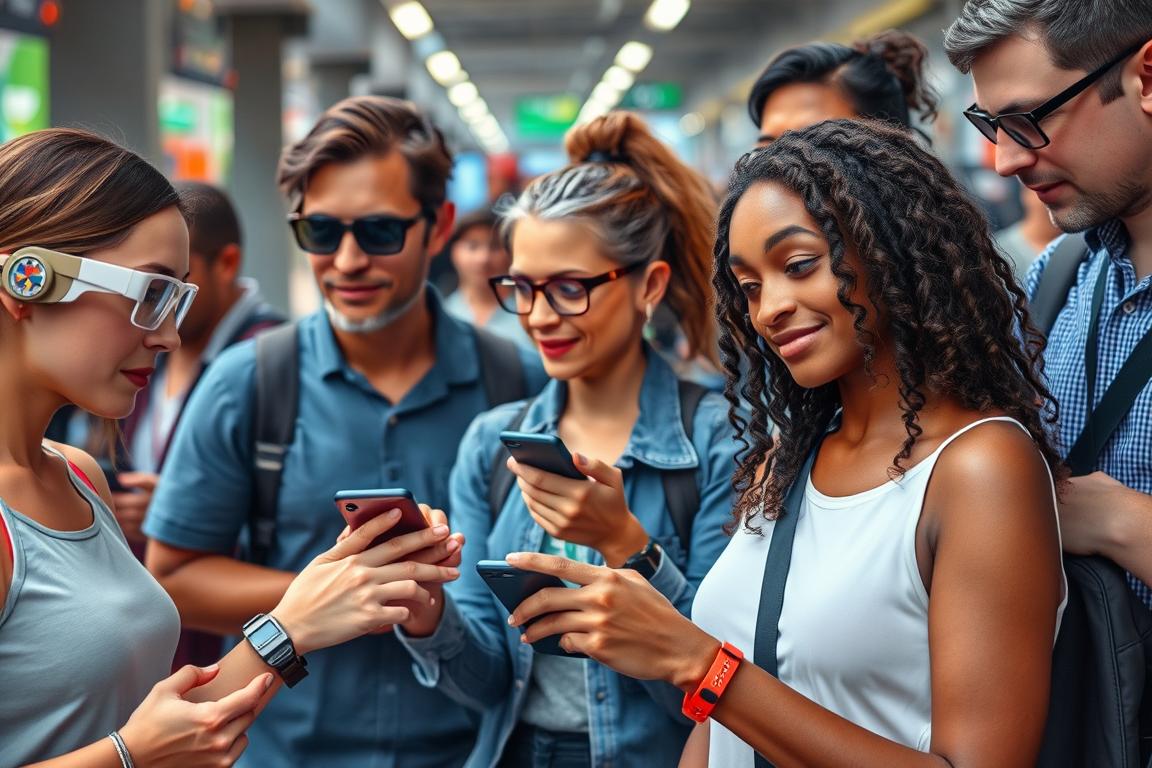Accessibility in Physical Environments: Practical Guide
More than 1 billion people, about 151,000 million people worldwide, have some form of disability. This shows the importance of accessibility in physical environments. It guarantees equal opportunities for all, promoting social inclusion.
THE accessibility in physical environments is essential for equal opportunities. It can be achieved with architectural adaptations, such as ramps and elevators. Assistive technologies, such as software, also help, and can be found in accessibility guides.
Architectural adaptations are crucial for social inclusion. They guarantee equal opportunities for all. accessibility in physical environments is a fundamental right, allowing people with disabilities to participate fully in society.
What is Accessibility in Physical Environments
Accessibility in physical environments is a right for people with disabilities. It is guaranteed by the Brazilian Inclusion Law. This means that accessibility standards are created so that everyone has equal access to information, products and services.
To ensure the accessibility for the disabled, it is necessary to make adaptations. For example, installing ramps, larger doors and adapted bathrooms. These changes are essential to include people with disabilities in physical spaces, allowing their full participation in society.
THE urban accessibility is also very important. It involves creating accessible and inclusive cities for everyone. This includes accessible sidewalks, traffic lights with sounds for those who are visually impaired, and adapted public transportation.
In conclusion, accessibility in physical environments is crucial. It ensures that all people, regardless of their abilities or limitations, have equal access to everything.
| Types of Accessibility | Examples |
|---|---|
| Accessibility for the Disabled | Access ramps, wide doors, adapted bathrooms |
| Urban Accessibility | Accessible sidewalks, traffic lights with sounds, adapted public transport |
Brazilian Legislation on Accessibility
Brazilian accessibility legislation defines rules to make spaces more accessible. This includes wheelchair accessibility. Law No. 10,098, of December 19, 2000, is a key point. It establishes the basic standards for accessibility.
Some of the main rules are:
- Reservation of parking spaces for vehicles transporting people with disabilities, equivalent to 2% of the total;
- Installation of accessible toilets in public bathrooms, in accordance with ABNT standards;
- Guarantee of at least one access free from architectural barriers in buildings for collective use;
- Installation of adapted elevators in buildings with more than one floor, except in single-family homes.
THE accessibility legislation It also highlights the importance of accessibility in public transport, events and health buildings. In addition, housing policy should reserve a percentage of housing for people with disabilities.
It is crucial that institutions and entrepreneurs know and apply these rules. This way, they ensure the wheelchair accessibility and equal opportunities for all.
Technical Standards and Accessibility Standards
Technical standards and accessibility standards are essential to ensure accessibility in physical locations. ABNT NBR 9050 is the Brazilian standard that defines accessibility criteria in buildings and public spaces. It addresses architectural adaptations important.
The standard was updated in 2020 to improve mobility for people with disabilities. This shows the importance of a well-planned accessibility project. Brazilian legislation also requires compliance with NBR 9050 in new projects and renovations.
The main requirements of NBR 9050 include the correct inclination of ramps and the installation of handrails on both sides of stairs. The legibility of signage is also important. These requirements are crucial for a physical accessibility project effective.
ABNT NBR 9050
ABNT NBR 9050 is an important milestone in promoting accessibility in Brazil. It offers clear guidelines for implementing architectural adaptations. Its adoption is essential to create inclusive and accessible environments.
Other Relevant Standards
In addition to NBR 9050, there are other relevant standards. ABNT NBR 16537:2018, for example, defines guidelines for tactile and visual signaling on the floor. These standards complement the guidelines of physical accessibility project and architectural adaptations.
Accessibility Certifications
Accessibility certification verifies that a space or building meets accessibility standards. This certification is essential to ensure that physical accessibility projects and architectural adaptations meet the needs of everyone. It promotes inclusion and accessibility.
Essential Elements for Accessible Environments
Accessibility in physical locations is crucial to the social inclusion. It allows everyone to participate in society. To make an environment accessible, it is important to consider several elements, such as ramps, elevators, signage and other resources.
Essential elements for accessible environments include:
- Access ramps with a maximum slope of 8.33%
- Doors with a minimum width of 80 cm
- Corridors and circulation areas with a minimum width of 90 cm
- Grab bars in bathrooms installed at a height of 70 cm to 80 cm
Tactile and visual signage are essential in public places. This is especially true in shopping malls and hospitals. Accessible bathrooms must have space for wheelchairs. They must have grab bars and sinks at appropriate heights.
Adopting accessibility requirements can increase tourism and trade. This can bring more customers and business opportunities. More than 201,000 people in Brazil have some kind of disability. Therefore, accessibility is essential for social inclusion.
Adaptations for Different Needs
Adapting spaces to different needs is essential for accessibility. accessibility for the disabled is a right. The accessibility standards help ensure equal opportunities.
Reduced Mobility
For those with reduced mobility, it is important to have ramps, handrails and tactile flooring. Adapted bathrooms are also crucial, with grab bars, sinks and raised toilets.
Visual Impairment
For those who are visually impaired, visual accessibility is vital. This includes adequate lighting, contrast between surfaces and objects. Braille signs help with orientation.
Hearing Impairment
For those who cannot hear, it is essential to have a sign language interpreter and audio description. They are essential for communication.
Examples of adaptations include:
- Access ramps
- Elevators
- Adapted bathrooms
- Sidewalks with tactile flooring

In short, adapting spaces to different needs is crucial. accessibility standards guarantee equality and accessibility for all.
| Adaptation | Description |
|---|---|
| Access ramps | For individuals with reduced mobility |
| Adequate lighting | For visually impaired people |
| Sign Language Interpreter | For individuals with hearing impairments |
Accessible Project Planning
Planning accessible projects is essential to making physical spaces accessible to everyone. This means creating a physical accessibility project with architectural adaptations that meet various needs.
When planning accessible projects, it is important to consider several things:
- Create accessible and easy-to-navigate spaces for people with disabilities;
- Include architectural adaptations such as ramps, elevators and accessible bathrooms;
- Use accessible and easy-to-use materials and technologies;
- Consult with experts and end users to ensure accessibility.
It is also crucial to follow the laws and accessibility standards, such as the Brazilian Inclusion Law and ABNT's NBR 9050. This ensures that the project complies with accessibility requirements.
With careful planning and the inclusion of architectural adaptations and physical accessibility project, it is possible to create inclusive spaces for everyone.
| Benefits of Accessible Project Planning | Description |
|---|---|
| Increased accessibility | Ensure that all users can access and use the space safely and effectively. |
| Improved user experience | Create an environment that is comfortable and pleasant for all users. |
| Compliance with accessibility laws and standards | Ensure that the project meets accessibility requirements and avoids legal issues. |
Implementation in Commercial Spaces
To guarantee accessibility in physical environments in stores is essential. This ensures equal opportunities for all. Law No. 10,098 of December 19, 2000, establishes rules for this.
THE social inclusion is also crucial. Companies with employees with disabilities improve their service. And they avoid prejudice in advertising campaigns. Companies that do not comply with the standards can be fined.
To improve the accessibility in physical environments, stores need to make adaptations. For example:
- Access ramps
- Adapted bathrooms
- Adapted elevators
- Handrails and tactile flooring
It is also important to hire people with disabilities. This is required by the Quota Law. See below the minimum percentages of disabled people required:
| Number of employees | Minimum percentage of PCDs |
|---|---|
| 100 to 200 | 2% |
| 201 to 500 | 3% |
| 501 to 1000 | 4% |
| From 1001 | 5% |
To learn more about technology that improves accessibility in physical environments and the social inclusion, visit the website Glowflower.
Accessibility in Public Spaces
Accessibility in public spaces is essential for equal opportunities. accessibility legislation in Brazil it requires that all places be accessible to people with disabilities.
The main challenges include lack of infrastructure, little information on accessibility and low investment in assistive technology.
To overcome these challenges, it is crucial that public transportation is accessible. Buses and subways should be adapted for wheelchair users and people with reduced mobility. In addition, businesses should be designed or adapted to be accessible, with adapted entrances and restrooms.
Some important measures to ensure accessibility include:
- Installation of suitable ramps and tactile flooring
- Braille signage and adapted bathrooms
- Adequate lighting and elimination of physical obstacles
- Training of public transport professionals
Accessibility is a fundamental right. It guarantees access to public and private spaces for all people, regardless of their physical condition. accessibility legislation and the urban accessibility are essential for a fair and inclusive society.
| Measure | Description |
|---|---|
| Ramp installation | Ensures access to public buildings and spaces for people with disabilities |
| Braille signage | Provides accessible information for people with visual impairments |
| Adequate lighting | Ensures safety and visibility in public spaces |
Technologies and Innovations in Accessibility
THE accessibility for the disabled is an essential right. Accessibility standards are crucial to include everyone. Advanced technology brings new solutions to improve accessibility in physical spaces.
Some of these technologies and innovations include:
- Portable Braille Printer
- “Loopwheels” wheels for wheelchair users
- Air Chair, a wheelchair for air travel
These modern solutions aim to increase the autonomy and quality of life of people with disabilities. They follow accessibility standards and promote inclusion.
Incremental innovation in accessibility is very important. It involves improving products and services to serve a more diverse audience. Artificial intelligence is seen as one of the main sectors with great growth potential in accessible technologies.
| Technology | Description |
|---|---|
| Screen reader | Software that converts text to speech |
| Image magnifier | Device that magnifies images for visually impaired people |
Maintenance and Monitoring
Maintenance and monitoring are essential for accessibility in physical locations. A physical accessibility project must have a maintenance plan. This ensures that the architectural adaptations remain in perfect condition.
Regularly checking ramps, elevators, and other equipment is crucial. It’s also important to take care of common areas, such as hallways and bathrooms. Regular audits help identify and improve areas that need adjustments.
Some important statistics include:
- 24.8% of stairs in health units are inaccessible
- 47.1% of the ramps in health units are inaccessible
- 75.8% of floors in health units are inaccessible
These data show the importance of maintenance and monitoring. The World Health Organization (WHO) also emphasizes the need for environments that promote physical activity at all ages.
In conclusion, maintaining and monitoring physical environments is essential for accessibility. This involves constantly checking equipment, taking care of common areas, and conducting periodic audits. These actions help create more inclusive and accessible spaces for everyone.
| Health Unit | Percentage of Inaccessibility |
|---|---|
| Steps | 24,8% |
| Ramps | 47,1% |
| Floors | 75,8% |
Conclusion
THE accessibility in physical environments It is essential to include people with disabilities. More than 500 students with disabilities study at the Federal University of Pará (UFPA). And 24 employees with disabilities work there as well.
However, we still face challenges, such as the lack of ramps and Braille solutions. We also need sign language interpreters.
Examples like Jose Monteiro and Rebecca Lopes Pereira show the importance of accessible environments. Around 231% of the Brazilian population has a disability. It is our responsibility to ensure equal opportunities for everyone.
Despite laws and technical standards on accessibility, their implementation is still a challenge. With the support of society and modern solutions, we can include more people. This way, everyone can enjoy public and private spaces.













